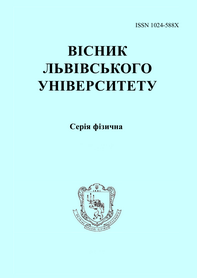DOI: https://doi.org/10.30970/vph.55.2018.71
Synthesis and photoluminescence of Tl4CdI6 and Tl4HgI6 nanocrystals embedded in natural cavities
M. Solovyov

| Visnyk of the Lviv University. Series Physics
55 (2018) с. 71-77
DOI: https://doi.org/10.30970/vph.55.2018.71 Synthesis and photoluminescence of Tl4CdI6 and Tl4HgI6 nanocrystals embedded in natural cavitiesM. Solovyov |  |
(не менше 1800 знаків) At present, of an actual problem of semiconductor microelectronics is the controlled change in the fundamental characteristics and spectral-kinetic parameters of semiconductors, in particular, such as: band gap, energy position and half-width of excitonic absorption bands and photoluminescence, etc., without changing the crystalline structure and chemical composition of materials. It is known that the above tasks can be practically realized by means of gradual reduction of dimensionality and volume of an object during the transition from a block three-dimensional to quasizero-dimensional crystal of a quantum dot type. Periodic lattices of microcrystals of various compounds synthesized in cavities of various matrices as well as those grown by epitaxial methods are the perspective model objects of quasizero-dimensional media whose properties are being actively studied. The main scientific interest in such objects is concentrated around the following questions: possibility of formation of a three-dimensional superlattice, regularities of renormalization of the energy spectrum of charge carriers, general problems of the theory of the electron energy spectrum at transforming the latter from purely three-dimensional, block monocrystalline types to quasithree-dimensional, two-dimensional, and zero-dimensional structures. In this connection, the present paper presents the results of studying the optical properties of Tl4CdI6 and Tl4HgI6 crystals synthesized in structural matrices of natural zeolite (mordenite), beryl and porous silicon at changing the structure and parameters of a matrix and realizing the conditions under which the predetermined discrete number of elementary cells of a crystal is formed in the quantum dot. In this paper, we consider the main approaches to the problem of dimensional quantization of the electron and exciton spectra of crystals and analyze the boundary conditions for existence of this effect depending on the size of quantum dot and other parameters of the crystal, in particular, such as: the ratio between the effective masses of carriers, the Bohr radius of exciton, etc.